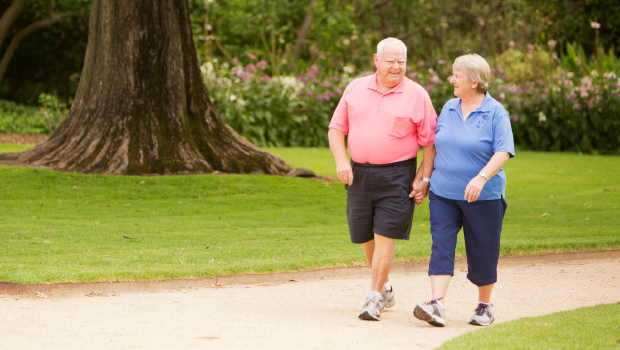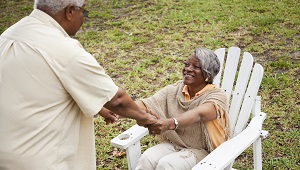We decreased people’s sedentary time—by an hour a day

Changing behavior isn’t easy, but Dr. Dori Rosenberg helped older people to stand and walk more.
By Dori Rosenberg, PhD, MPH, associate investigator at Kaiser Permanente Washington Health Research Institute
Let me start by mentioning that I’m upright at my standing desk as I write this. Yet we’re in environments that cue us to sit all the time. And staying home during the COVID-19 pandemic can make it even harder to remember we’ve been sitting for too long. For example, if you typically walk to get to the bus to work, that is automatic physical activity built into your day that no longer happens. So we all have to be more conscious around decisions to stand and move to break up long periods of sitting.
Habits of sedentary behavior—sitting and lying down—and of physical activity are distinct from each other: You can work out at the gym for an hour a day but still spend too long sitting. Researchers have long noted a correlation between sedentary behavior and obesity, heart disease, high blood pressure, and metabolic syndrome. And the prevalence of sedentary behavior, and of those conditions, rises with age. We actually don’t know, with good study designs, whether the relationships between sitting and those conditions are causal.
Older adults have particularly high levels of sitting: an average of more than 8.5 hours a day. They also tend not to achieve the 7,000 steps per day minimum that is suggested for them. It may make more sense to help older adults with obesity to increase the time they spend standing, rather than doing physical activity.
The first step is to see whether we can even get people to raise their standing time—and reduce their sitting time and their sedentary behavior. I’m a clinical health psychologist, and I know how difficult it can be for people to change their habits.
That’s why I’m so excited that we were able to reduce sitting time by about an hour a day in our new randomized controlled trial: “Reducing Sitting Time in Obese Older Adults: The I-STAND Randomized Controlled Trial,” in the Journal of Aging and Physical Activity. Instead of sitting, the older adults in our study spent more time standing, and they had fewer prolonged sessions of sitting for a half-hour or more. Although they took slightly more steps (286/day), their physical activity didn’t increase much.
Our trial is the first randomized controlled trial of sitting reduction in older adults with obesity. Compared to prior studies, it lasted longer—12 weeks—and included more people: 60 patients at Kaiser Permanente Washington. We found that the intervention was safe, and the participants were very satisfied with it.
Tips for sitting less
We used practical strategies to help people break up their sitting time throughout the day through a combination of standing more and taking frequent, brief breaks from sitting. These strategies involved brief coaching contacts, habit reminders to take breaks from sitting, and setting individual goals to reduce sitting time by standing and moving more. We gave participants a device to wear on their wrist to with alerts every 15 minutes of inactivity to remind participants to take breaks from sitting (we used the Jawbone UP fitness tracking wristband). We also used a device worn on the thigh called an activPAL to measure time spent lying down, sitting, standing, and moving—and showed participants feedback charts of their time.
Our trial didn’t have enough people to have the statistical power to detect changes in health outcomes. But it did show trends toward lower weight, BMI, waist circumference, and blood pressure—just not significant ones.
I am an advocate for patients, and I must thank our generous participants who took part in the trial. Thanks also to my colleagues and coauthors Jennifer McClure, Melissa Anderson, Anne Renz, Theresa Matson, Amy Lee, Mikael Anne Greenwood-Hickman, and David Arterburn at Kaiser Permanente Washington Health Research Institute, Paul Gardiner at the University of Brisbane in Australia, and Jacqueline Kerr at the Grant Doctor in San Diego. The National Institutes of Health and the National Institute on Aging (K23HL119352, R21AG043853) funded our work.
More research is needed to see which intervention components are most useful for sustained reduction of sitting behavior over longer periods—and whether standing more improves health outcomes. We think that messages to sit less could be encouraged more broadly, such as through medical settings, for people with who struggle with physical activity.
By the way, I’m still standing. Why not join me?
healthy communities

How should we study the health of neighborhoods?
UW/KPWHRI research team confers with King County organizations at its "Moving to Health" Summit, sparking new collaborations.
Healthy Aging

Stand up for your health!
Researcher Dori Rosenberg shares the importance of being less sedentary — and tips for sitting less.
video

Take a break from sitting
Get up, stand up: Pilot study coaches older adults to take active breaks from sitting
(YouTube, 2:40)


